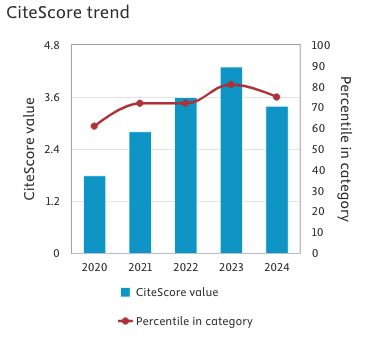Comparison of SpO2/FiO2 ratio and PAO2/FIO2 ratio as initial assessment in patients at risk of respiratory failure
Keywords:
Respiratory failure, SpO2/FiO2 ratio, PaO2/FiO2 ratio, shortness of breathAbstract
Introduction: The risk of respiratory failure such as shortness of breath which causes difficulty in the breathing process, if not treated properly can result in respiratory failure, then organ failure with high morbidity and mortality. These risks can be identified by measuring oxygen saturation with oximetry. The purpose of this study is to determine and examine the comparison of the Oxygen saturation/Fraction of inspired oxygen (SpO2/FiO2) ratio and the Partial pressure of oxygen /Fraction of inspired oxygen (PaO2/FiO2) ratio as an initial assessment in patients at risk of respiratory failure. Methods: Cross-sectional study conducted among patients in the emergency room and treatment room at Wahidin Sudirohusodo Hospital Makassar and its network with symptoms of shortness of breath. The data collected from the results of blood gas analysis, oxygen saturation examinations, and patient medical records. Results: A total of 103 samples were obtained with an age range of 20-87 years. Based on the data, the mean SpO2 value was 95.7%, PaO2 was 163.3 mmHg, FiO2 was 70.7%, SpO2/FiO2 ratio was 175.1 mmHg and PaO2/FiO2 ratio was 332.2 mmHg. The threshold value of the SpO2/FiO2 ratio for respiratory failure of 281 corresponds to the PaO2/FiO2 ratio of 300 with a sensitivity of around 93% and a specificity of 96%. Conclusion: The SpO2/FiO2 ratio was strongly correlated with the PaO2/FiO2 ratio in assessing respiratory failure. So, the SpO2/FiO2 ratio can be used as an alternative to the PaO2/FiO2 ratio for early detection in patients at risk of respiratory failure.
References
1. American Thoracic Society. Dyspnea: Mechanism, assessment, and management: a consensus statement. Am J Respir Crit Care Med. 1999; 159:321-40. doi: 10.1164/ajrccm.159.1. ats898
2. Mehta TR, Shah CT, Lakhani JD, Lakhani D. Can pulse oximetric saturation (SpO2)/fraction of inspired oxygen (FiO2) ratio surrogate PaO2/ FiO2 ratio in diagnosing acute respiratory failure? International Journal of Biomedical and Advance Research. 2016; 7(5): 242-246. doi: 10.7439/ijbar
3. Vincent JL, Akça S, Mendonça A, et al. The epidemiology of acute respiratory failure in critically ill patients. Chest. 2002; 121: 1602-9.doi: org/10.1378/chest.121.5.1602
4. Sue DY and Bongard FS. Respiratory Failure. In Current Critical Care Diagnosis and Treatment - 2nd edition. 2003. California. Lange-McGrawHill. 2003. Pp. 269-89. doi: 10.1186/cc2371
5. Pisani L, Roozeman JP, Simonis FD, et al. Risk stratification using SpO2/FiO2 and PEEP at initial ARDS diagnosis and after 24 h in patients with moderate or severe ARDS. Ann Intensive Care. 2017;7(1). doi: 10.1186/s13613-017-0327-9
6. Babu S, Abhilash KPP, Kandasamy S, Gowri M. Association between SpO2 / FiO2 Ratio and PaO2 / FiO2 Ratio in Different Modes of Oxygen Supplementation. Indian J Crit Care Med. 2021; 25(9):1001-1005. doi: 10.5005/jp-journals-10071-23977
7. Matthay MA, Arabi Y, Arroliga AC, et al. WORKSHOP A New Global Definition of Acute Respiratory Distress Syndrome. Am J Respir Crit Care Med. 2024;209(1):37-47. doi: org/10.1164/rccm.202303-0558WS
8. Festic E, Bansal V, Kor DJ, Gajic O. SpO2/FiO2 ratio on hospital admission is an indicator of early acute respiratory distress syndrome development among patients at risk. J Intensive Care Med. 2015;30(4):209-216. doi: org/10.1177/0885066613516411
Downloads
Published
Issue
Section
License
Copyright (c) 2025 Mohammad Gilang Fajriansyah Nohu, Satriawan Abadi, Harun Iskandar, Syakib Bakri, Hasyim Kasim, Andi Alfian Zainuddin

This work is licensed under a Creative Commons Attribution-NonCommercial 4.0 International License.
This is an Open Access article distributed under the terms of the Creative Commons Attribution License (https://creativecommons.org/licenses/by-nc/4.0) which permits unrestricted use, distribution, and reproduction in any medium, provided the original work is properly cited.
Transfer of Copyright and Permission to Reproduce Parts of Published Papers.
Authors retain the copyright for their published work. No formal permission will be required to reproduce parts (tables or illustrations) of published papers, provided the source is quoted appropriately and reproduction has no commercial intent. Reproductions with commercial intent will require written permission and payment of royalties.






